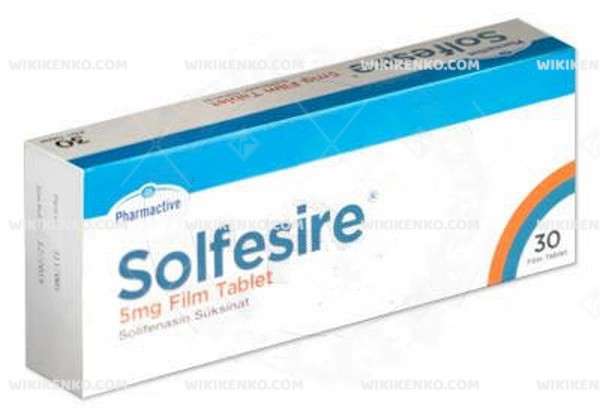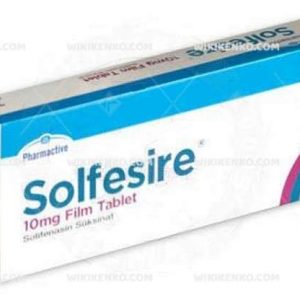Solfesire Film Tablet 5 Mg
Solfesire Film Tablet 5 Mg is a pharmaceutical remedy designed to alleviate the troubling symptoms of an overactive bladder. Widely available in Turkey and sourced from Turkish pharmaceutical outlets, this medication offers respite for those grappling with the challenges of this condition.
| Dosage form | |
|---|---|
| Pack size | |
| Potency | 5 Mg |
| Manufacturer | |
| Origin | |
| Generic Name (Ingredient) | Solifenacin Succinate 5 Mg |
Assuming your emergency circumstances for this product, visit Urgent Quotation page. Besides, for any pharmaceutical questions, please ask us in the comments section.
Description
At the core of Solfesire lies its active ingredient, Solifenacin Succinate. Each tablet contains 5 mg of this potent compound, which serves as the driving force behind the medication’s efficacy.
Bladder Symptoms
Solfesire steps in as a crucial player in mitigating the symptoms of an overactive bladder. This often manifests as frequent and urgent urination, accompanied by the distressing issue of incontinence or urine leakage. Furthermore, it extends its therapeutic reach to address overactive bladder conditions stemming from neurological disorders such as multiple sclerosis or spinal cord injuries in children aged at least 2 years when other treatments have either failed or cannot be used.
Side Effects
Despite its merits, Solfesire is not without potential side effects. Those who embark on this therapeutic journey may encounter common side effects, including:
- Hot and dry skin
- An unquenchable thirst
- Intense abdominal discomfort or constipation
- Pain or burning sensations during urination
- Halted urination
| Common Side Effects |
|---|
| – Hot and dry skin |
| – Extreme thirst |
| – Severe stomach pain or constipation |
| – Pain or burning when you urinate |
| – Stop urinating |
It’s pivotal to grasp that this list is not exhaustive, and alternative side effects may surface. In the presence of any of these symptoms, it is imperative to initiate a dialogue with your healthcare provider promptly. Comprehensive consultation is essential to establish the applicability of this information to your unique circumstances.
Efficacy Duration
Understanding the dynamics of how Solfesire takes effect is pivotal. Following oral administration in healthy volunteers, the peak levels of Solifenacin surface within 3-8 hours. This marks the moment when the medication begins to exert its influence. Nonetheless, the timing of this effect can fluctuate, contingent on individual factors including age, weight, overall health, and concurrent medications. As such, personalized information should always be gleaned from a healthcare provider.
Solfesire Film Tablet 5 Mg Benefits
Solfesire Film Tablet 5 Mg ushers in a bevy of advantages, chiefly concentrated on taming the symptoms associated with an overactive bladder. These key benefits include:
Urgency Control
Solfesire plays a pivotal role in curbing the urgency to empty the bladder. It achieves this by regulating bladder contractions, offering individuals the ability to regain control and reduce disruptive trips to the restroom.
Diminished Urinary Frequency
Through the reduction of urination frequency, Solfesire empowers individuals to enjoy fewer intrusive visits to the bathroom, offering improved quality of life.
Treating Overactive Bladder Syndrome
Solfesire proves indispensable in addressing the challenges posed by urinary incontinence and heightened urinary frequency, often stemming from an overactive bladder.
Pediatric Use
Notably, Solfesire can be administered to treat overactive bladder conditions arising from neurological disorders in children aged at least 2 years, where conventional treatments have proven ineffective.
It’s crucial to emphasize that while these benefits promise enhanced quality of life for those facing these conditions, the medication’s usage should always be supervised by a healthcare provider due to potential side effects and interactions with other drugs.
Precautions
The path to optimal usage of Solfesire requires the acknowledgment of a set of precautions. Before initiating Solfesire usage, it is vital to inform your healthcare provider if you have:
- Glaucoma
- Liver disease
- Kidney disease
- A stomach or intestinal blockage
- A history of Long QT syndrome
Furthermore, vigilance against overdose is pivotal. Overdose symptoms may encompass blurred vision, dilated pupils, severe drowsiness, tremors, and exceedingly dry skin. Suspected overdoses necessitate immediate medical attention, and the American Association of Poison Control Centers stands ready at 1-800-222-12222 to offer guidance.
Proper storage of Solfesire is also an essential component of responsible usage. It should be kept at room temperature, between 59 and 86 degrees F (15 and 30 degrees C), safeguarded against heat, moisture, and light. Importantly, it should be stored outside of the bathroom and beyond the reach of children and pets.
Special Considerations
Patients exhibiting severe renal impairment (creatinine clearance less than 30 ml/min) should proceed with caution and restrict their intake to no more than 5 mg per day. For patients with moderate hepatic impairment (Child-Pugh B), doses exceeding 5 mg are not recommended. Furthermore, Solfesire is contraindicated for patients with severe hepatic impairment (Child-Pugh C).
Caution in Daily Activities
Given the potential effects of Solfesire, individuals are advised to avoid engaging in activities that demand heightened attention and coordination, such as driving, until they are aware of the medication’s impact on their reactions.
Guarding Against Heat
Solfesire has the potential to reduce perspiration, increasing the susceptibility to heat stroke. It is advised to avoid overheating or dehydration, especially during exercise and hot weather.
Dosage
Ingrained in the usage of Solfesire is the need to align the dosage with individual needs. The recommended daily dose commences at 5 mg, offering a stable starting point. If this initial dose proves tolerable, the potential exists to escalate it to 10 mg daily. The mode of administration remains consistent – it should be ingested with water, whole, and can be consumed with or without food.
| Dosage | Administration |
|---|---|
| Recommended Dose: 5 mg, may increase to 10 mg if well tolerated | With water, swallowed whole, with or without food |
| Dose Adjustment in Patients with Renal Impairment | Dose Adjustment in Patients with Hepatic Impairment |
| For patients with severe renal impairment (CLcr < 30 mL/min), a daily dose of Solfesire greater than 5 mg is not recommended | For patients with moderate hepatic impairment (Child-Pugh B), a daily dose of Solfesire greater than 5 mg is not recommended. |
| Dose Adjustment in Patients Taking CYP3A4 Inhibitors | Contraindications for Solfesire Film Tablet 5 Mg |
| When administered with potent CYP3A4 inhibitors such as ketoconazole, a daily dose of Solfesire greater than 5 mg is not recommended | Solfesire Film Tablet 5 Mg should not be used in the following conditions: |
| Urinary Retention: Patients who cannot urinate or completely empty their bladder should not use it. | |
| Severe Gastrointestinal Condition: This includes a complication associated with ulcerative colitis called toxic megacolon. | |
| Myasthenia Gravis: This is a muscle disease that can cause severe weakness in certain muscles. | |
| Narrow Angle Glaucoma: Patients with high pressure in the eyes accompanied by partial vision loss should not use Solfesire. | |
| Hypersensitivity: Patients who are allergic to Solifenacin or any other ingredients in it should not use this medication. |
Contraindications
Solfesire Film Tablet 5 Mg should be approached with a measure of caution and restraint, especially in situations where its use is not recommended. The following conditions warrant abstaining from its use:
- Urinary Retention: Individuals who face an inability to urinate or entirely empty their bladder should not consider Solfesire.
- Severe Gastrointestinal Conditions: This prohibition encompasses complications linked to ulcerative colitis, such as toxic megacolon.
- Myasthenia Gravis: Individuals grappling with this muscle disease, which leads to pronounced muscle weakness, should steer clear of Solfesire.
- Narrow Angle Glaucoma: Those burdened with high eye pressure resulting in partial vision loss should refrain from Solfesire.
- Hypersensitivity: Individuals manifesting allergies to Solifenacin or any other components within Solfesire should refrain from its use.
The foregoing list is not exhaustive, and there may be additional situations where its usage is contraindicated. Therefore, it is paramount to engage in thorough consultation with a healthcare provider, ensuring personalized guidance for the journey ahead.
Conclusion
In conclusion, Solfesire Film Tablet 5 Mg assumes a vital role in the management of overactive bladder symptoms. Its unique formulation, guided by the active ingredient Solifenacin Succinate, empowers individuals to regain control over their lives. Nevertheless, this therapeutic expedition must be navigated with the guidance of a healthcare provider, for the path is rife with potential side effects and interactions with other medications.
Thus, the role of the healthcare provider cannot be overstated. Their expertise and insights are invaluable as they tailor the treatment to the individual’s specific needs. This article, though informative, serves as an adjunct to professional medical consultation, not a replacement. The journey toward wellness is a collaborative endeavor, and the healthcare provider stands as a steadfast companion in this pursuit.
Use the form below to report an error
Please answer the questions as thoroughly and accurately as possible. Your answers will help us better understand what kind of mistakes happen, why and where they happen, and in the end the purpose is to build a better archive to guide researchers and professionals around the world.
The information on this page is not intended to be a substitute for professional medical advice, diagnosis, or treatment. always seek the advice for your physician or another qualified health provider with any questions you may have regarding a medical condition. Always remember to
- Ask your own doctor for medical advice.
- Names, brands, and dosage may differ between countries.
- When not feeling well, or experiencing side effects always contact your own doctor.
Cyberchondria
The truth is that when we’re sick, or worried about getting sick, the internet won’t help.
According to Wikipedia, cyberchondria is a mental disorder consisting in the desire to independently make a diagnosis based on the symptoms of diseases described on Internet sites.
Why you can't look for symptoms on the Internet
If diagnoses could be made simply from a textbook or an article on a website, we would all be doctors and treat ourselves. Nothing can replace the experience and knowledge of specially trained people. As in any field, in medicine there are unscrupulous specialists, differences of opinion, inaccurate diagnoses and incorrect test results.




Reviews
There are no reviews yet.